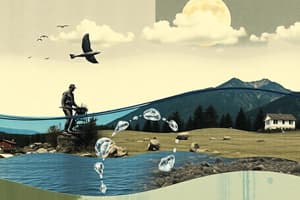Podcast
Questions and Answers
What is precipitation?
What is precipitation?
- Any form of water that falls from clouds (correct)
- Evaporation of water from plant leaves
- The change of a liquid to a gas
- Flow of water from the land surface into the subsurface
What is evaporation?
What is evaporation?
The change of a liquid to a gas.
What is condensation?
What is condensation?
Gas to liquid.
What is transpiration?
What is transpiration?
What is the hydrologic cycle?
What is the hydrologic cycle?
What is infiltration?
What is infiltration?
What is runoff?
What is runoff?
What is root uptake?
What is root uptake?
What does the prefix 'hydro' mean?
What does the prefix 'hydro' mean?
What is an aquitard?
What is an aquitard?
What is a reservoir?
What is a reservoir?
What does permeable mean?
What does permeable mean?
What does impermeable mean?
What does impermeable mean?
What is an aquifer?
What is an aquifer?
What is another definition of infiltration?
What is another definition of infiltration?
What is a contaminant?
What is a contaminant?
What is the atmosphere?
What is the atmosphere?
What is the sun?
What is the sun?
What is water vapor?
What is water vapor?
What is groundwater?
What is groundwater?
What are five uses of water?
What are five uses of water?
Flashcards are hidden until you start studying
Study Notes
Precipitation
- Refers to water falling from clouds, encompassing forms such as hail, snow, sleet, and rain.
- Occurs when clouds become heavy and the atmosphere cannot support the moisture.
Evaporation
- The process where liquid water transforms into vapor due to the sun's heat.
- A vital step in the hydrologic cycle, contributing to atmospheric moisture.
Condensation
- The transformation of gas back into liquid as it cools, resulting in cloud formation.
- Plays a critical role in the water cycle by facilitating precipitation.
Transpiration
- Evaporation of water from plant leaves contributes to the water cycle.
- Plants release purified water vapor, which can enter the atmosphere.
Hydrologic Cycle (Water Cycle)
- Describes the continuous movement of water in the hydrosphere.
- Involves evaporation, condensation, precipitation, and both surface and groundwater runoff and infiltration.
Infiltration (Seepage)
- The process by which water flows from the land surface into the subsurface soil.
- Essential for replenishing groundwater supplies as rainwater soaks into the ground.
Runoff
- Occurs when excess water flows over the surface without being absorbed into soil.
- This surplus water eventually makes its way to rivers, lakes, and oceans.
Root Uptake
- The mechanism through which plant roots absorb water from the soil.
- Critical for plant health and growth, supporting photosynthesis and other biological functions.
Meaning of the Prefix "Hydro"
- "Hydro" translates to "water," indicating its relation to various water processes and systems.
Aquitard
- Consists of impermeable materials that do not allow water storage or movement.
- Prevents the upward flow of water to aquifers and can impede groundwater recharge.
Reservoir
- A storage area, usually a lake, created to hold water for human use.
- Essential for providing drinking water, irrigation, and recreational activities.
Permeable
- Describes materials that facilitate the flow of liquids through them.
- Important for groundwater movement and the effectiveness of aquifers.
Impermeable
- Refers to materials that do not permit the passage of liquids.
- Affects water movement and storage in the hydrological context.
Aquifer
- Comprises permeable materials capable of collecting and storing water.
- Serves as crucial sources of groundwater for various uses.
Infiltration
- Similar to seepage, it indicates the process of water soaking through soil or permeable materials.
- Important for groundwater replenishment and ecological balance.
Contaminant
- Any substance that introduces impurities or pollution into a medium.
- Particularly significant in discussions about water quality and safety.
Atmosphere
- The layer of gases surrounding a planet or moon, composed of various elements.
- Crucial for sustaining life, weather patterns, and the hydrologic cycle.
Sun
- A typical star that provides light and heat essential for supporting life on Earth.
- Drives the processes of evaporation and photosynthesis.
Water Vapor
- The gaseous state of water, essential for cloud formation and precipitation.
- Plays a key role in atmospheric moisture and climate dynamics.
Groundwater
- Water located underground, filling cracks and spaces in soil and rock layers.
- A significant source of fresh water, used for drinking and irrigation.
Uses of Water
- Vital for drinking, cleaning, livestock needs, energy generation, and industrial purposes.
- Highlights the importance of water in daily life and socioeconomic activities.
Studying That Suits You
Use AI to generate personalized quizzes and flashcards to suit your learning preferences.




